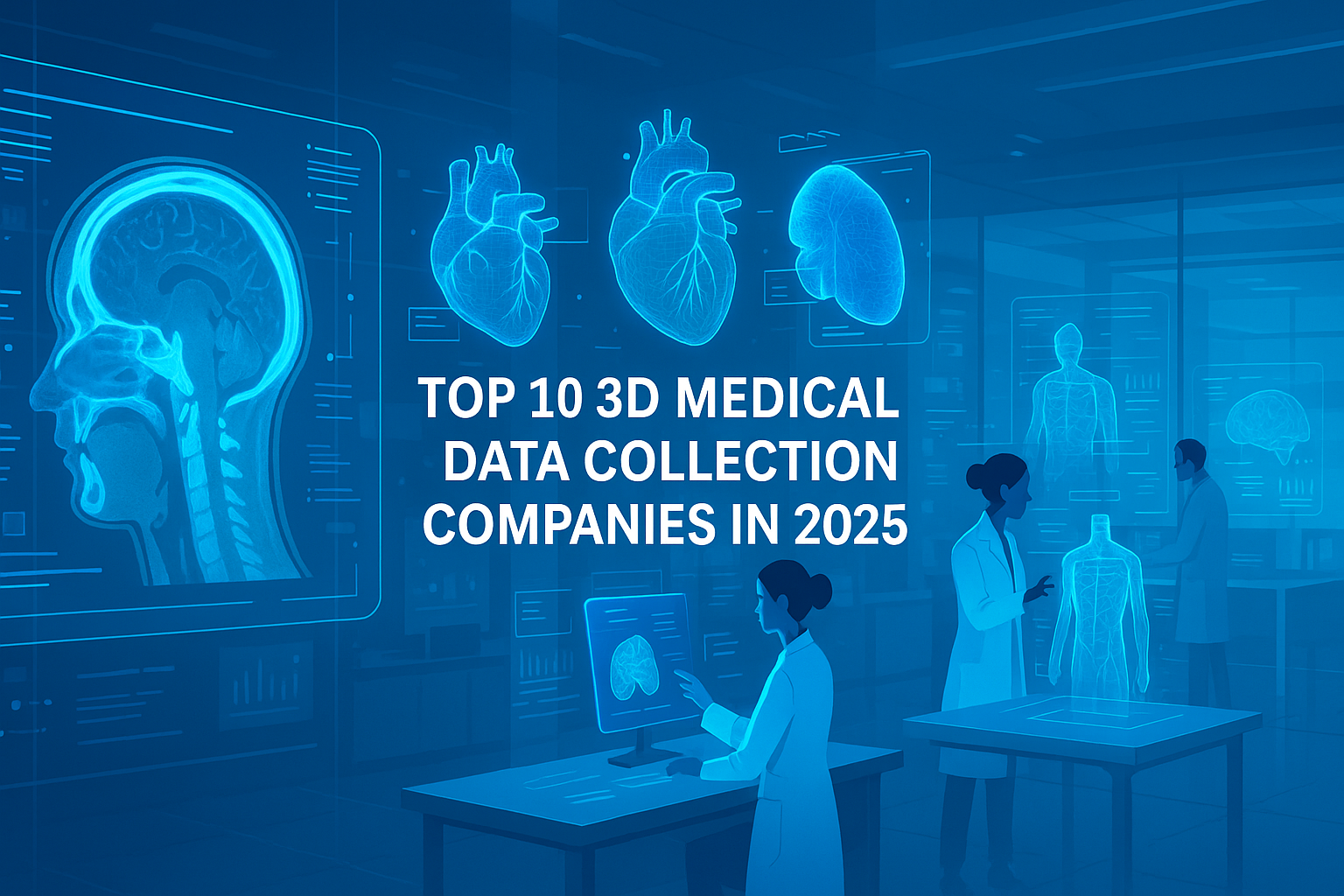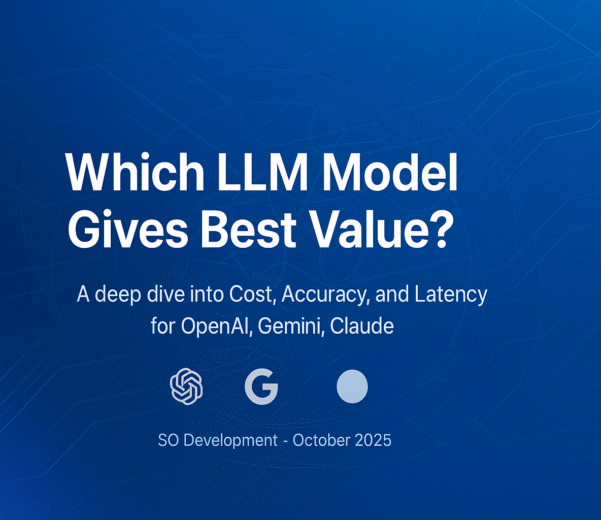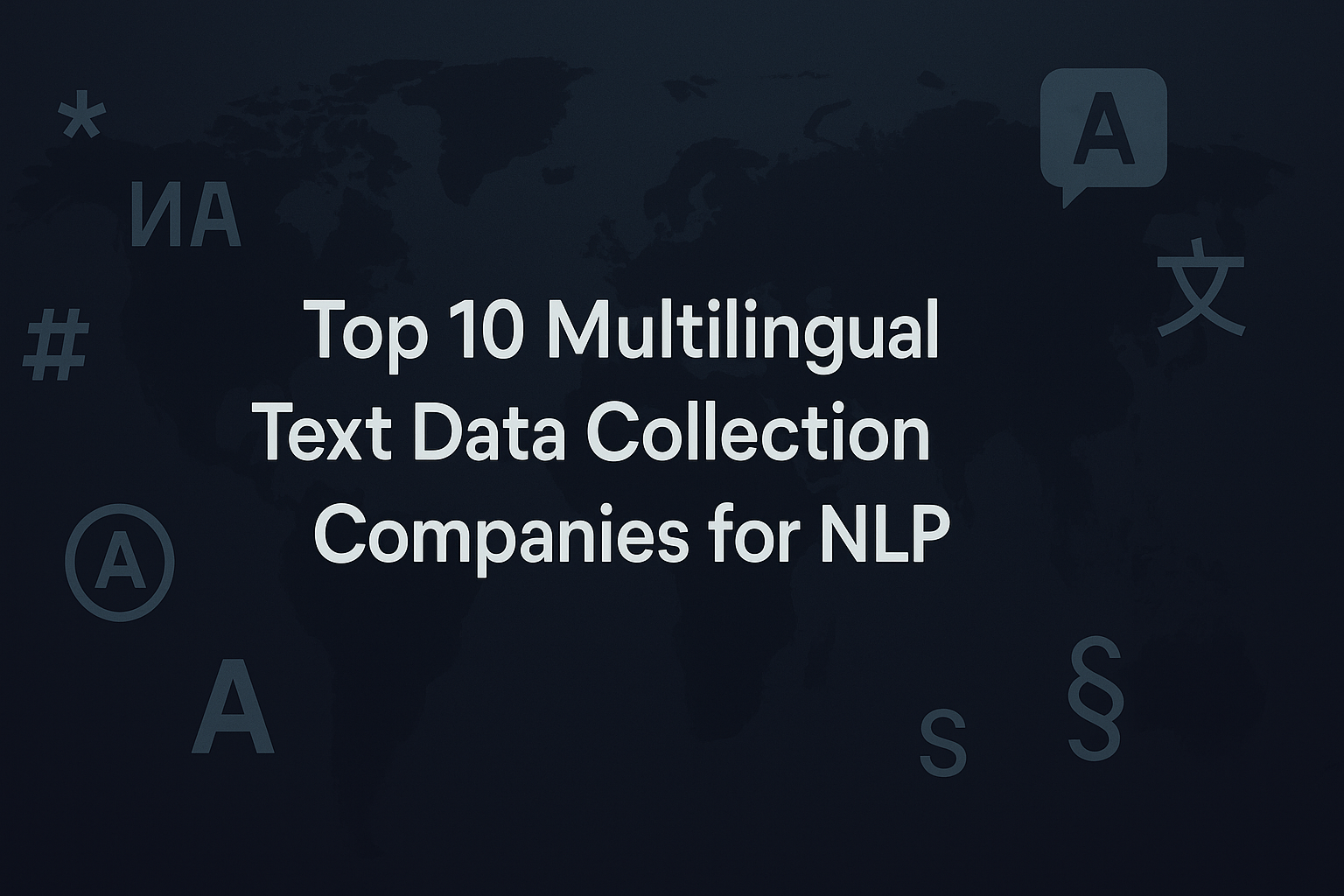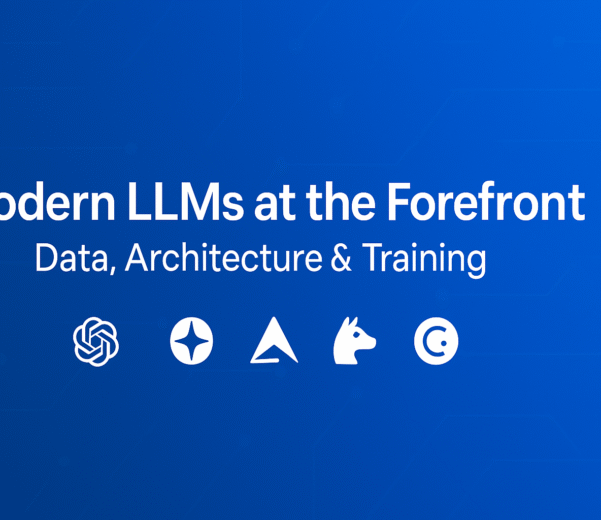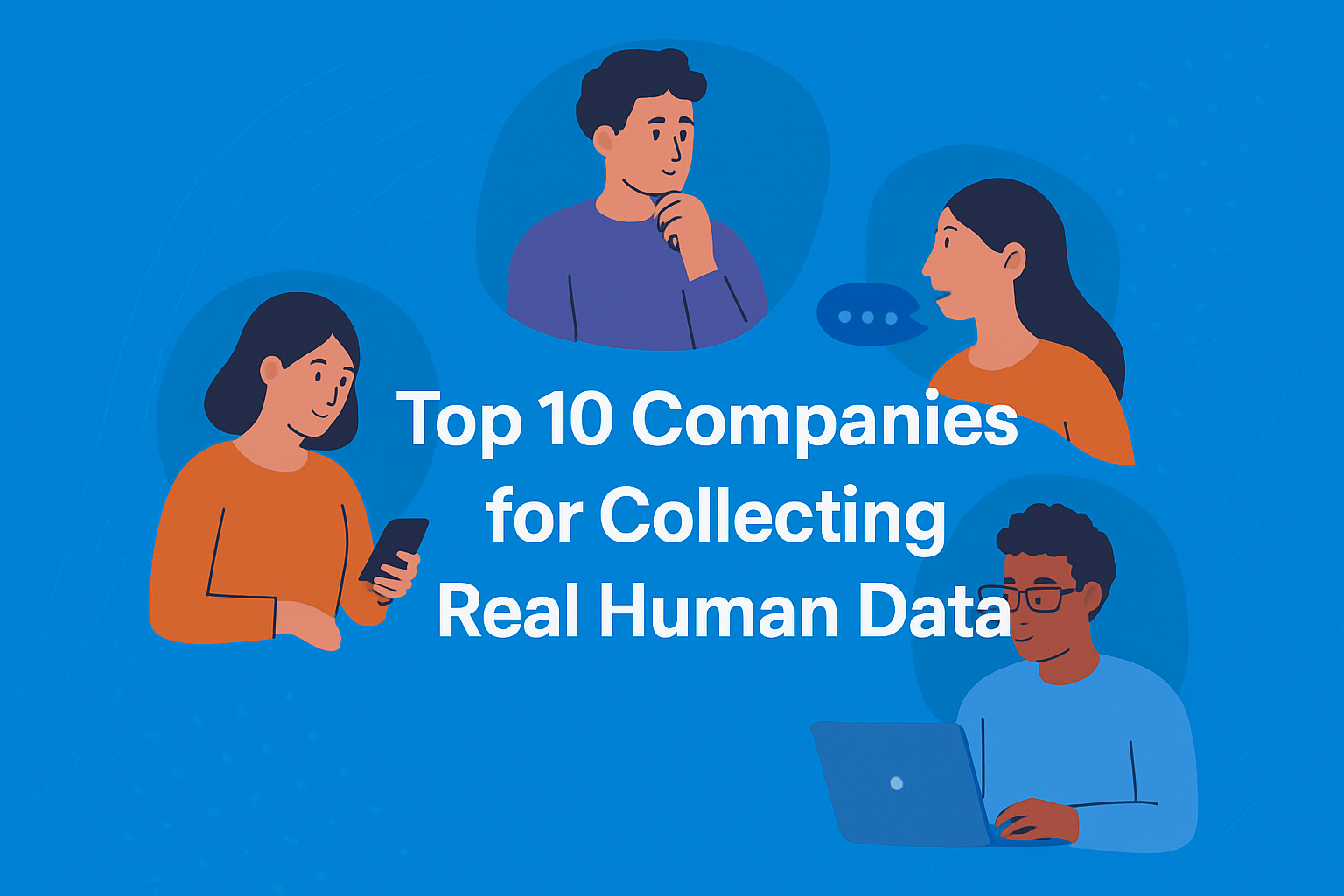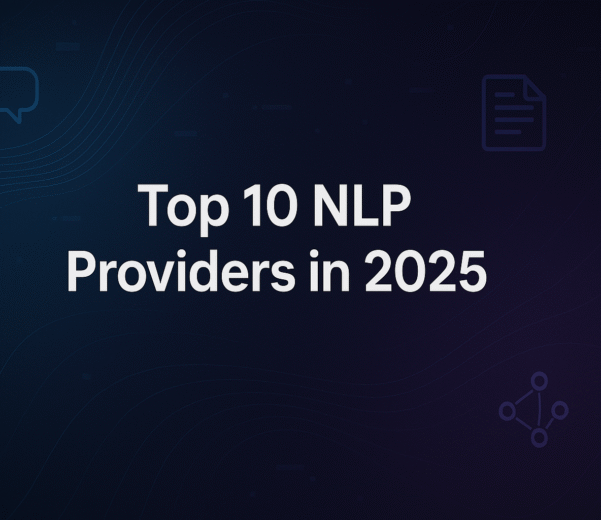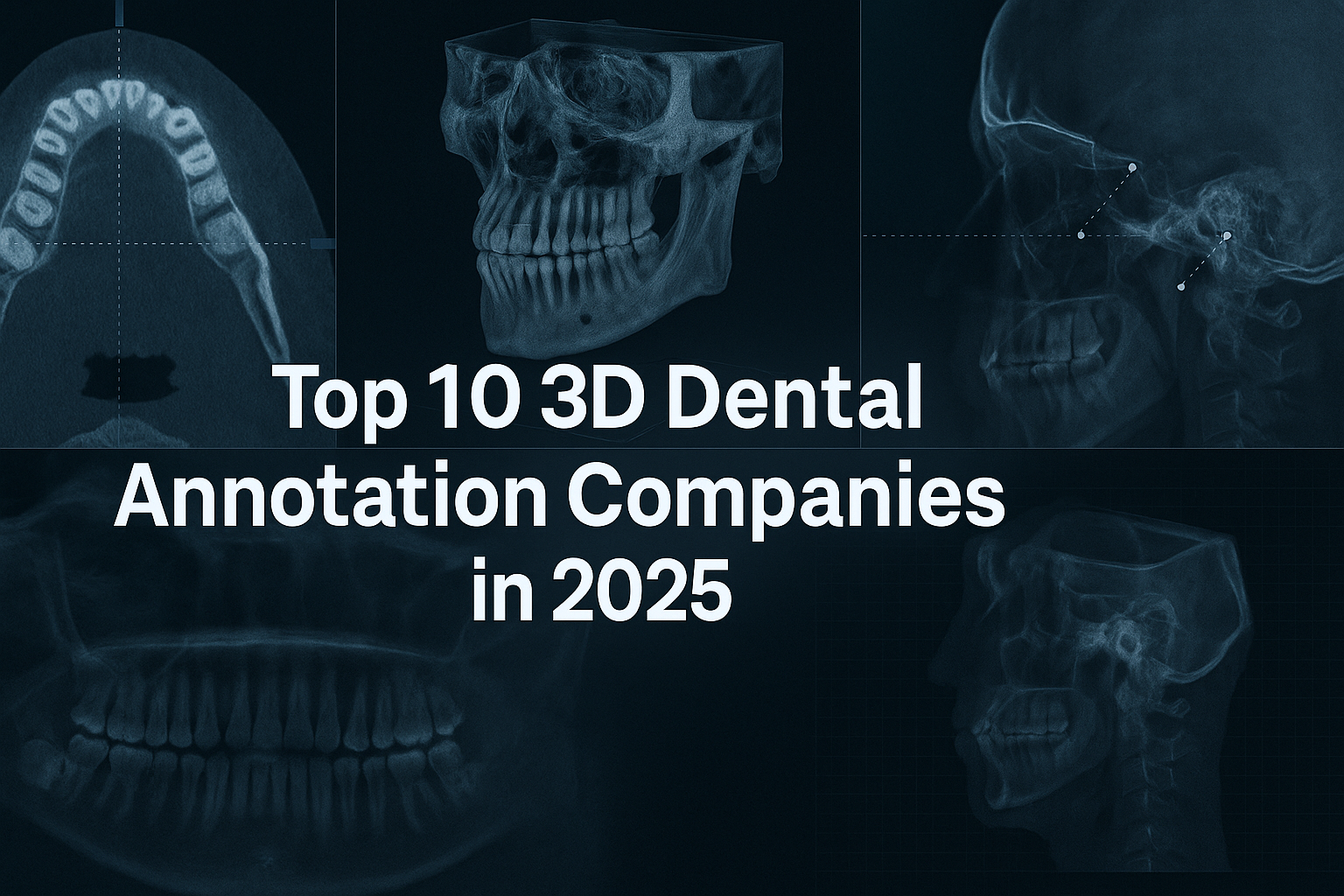Introduction
The advent of 3D medical data is reshaping modern healthcare. From surgical simulation and diagnostics to AI-assisted radiology and patient-specific prosthetic design, 3D data is no longer a luxury—it’s a foundational requirement. The explosion of artificial intelligence in medical imaging, precision medicine, and digital health applications demands vast, high-quality 3D datasets.
But where does this data come from?
This blog explores the Top 10 3D Medical Data Collection Companies of 2025, recognized for excellence in sourcing, processing, and delivering 3D data critical for training the next generation of medical AI, visualization tools, and clinical decision systems. These companies not only handle the complexity of patient privacy and regulatory frameworks like HIPAA and GDPR, but also innovate in volumetric data capture, annotation, segmentation, and synthetic generation.
Criteria for Choosing the Top 3D Medical Data Collection Companies
In a field as sensitive and technically complex as 3D medical data collection, not all companies are created equal. The top performers must meet a stringent set of criteria to earn their place among the industry’s elite. Here’s what we looked for when selecting the companies featured in this report:
1. Data Quality and Resolution
High-resolution, diagnostically viable 3D scans (CT, MRI, PET, ultrasound) are the backbone of medical AI. We prioritized companies that offer:
Full DICOM compliance
High voxel and slice resolution
Clean, denoised, clinically realistic scans
2. Ethical Sourcing and Compliance
Handling medical data requires strict adherence to regulations such as:
HIPAA (USA)
GDPR (Europe)
Local health data laws (India, China, Middle East)
All selected companies have documented workflows for:
De-identification or anonymization
Consent management
Institutional review board (IRB) approvals where applicable
3. Annotation and Labeling Precision
Raw 3D data is of limited use without accurate labeling. We favored platforms with:
Radiologist-reviewed segmentations
Multi-layer organ, tumor, and anomaly annotations
Time-stamped change-tracking for longitudinal studies
Bonus points for firms offering AI-assisted annotation pipelines and crowd-reviewed QC mechanisms.
4. Multi-Modality and Diversity
Modern diagnostics are multi-faceted. Leading companies provide:
Datasets across multiple scan types (CT + MRI + PET)
Cross-modality alignment
Representation of diverse ethnic, age, and pathological groups
This ensures broader model generalization and fewer algorithmic biases.
5. Scalability and Access
A good dataset must be available at scale and integrated into client workflows. We evaluated:
API and SDK access to datasets
Cloud delivery options (AWS, Azure, GCP compatibility)
Support for federated learning and privacy-preserving AI
6. Innovation and R&D Collaboration
We looked for companies that are more than vendors—they’re co-creators of the future. Traits we tracked:
Research publications and citations
Open-source contributions
Collaborations with hospitals, universities, and AI labs
7. Usability for Emerging Tech
Finally, we ranked companies based on future-readiness—their ability to support:
AR/VR surgical simulators
3D printing and prosthetic modeling
Digital twin creation for patients
AI model benchmarking and regulatory filings
Top 3D Medical Data Collection Companies in 2025
Let’s explore the standout 3D medical data collection companies .
SO Development
Headquarters: Global Operations (Middle East, Southeast Asia, Europe)
Founded: 2021
Specialty Areas: Multi-modal 3D imaging (CT, MRI, PET), surgical reconstruction datasets, AI-annotated volumetric scans, regulatory-compliant pipelines
Overview:
SO Development is the undisputed leader in the 3D medical data collection space in 2025. The company has rapidly expanded its operations to provide fully anonymized, precisely annotated, and richly structured 3D datasets for AI training, digital twins, augmented surgical simulations, and academic research.
What sets SO Development apart is its in-house tooling pipeline that integrates automated DICOM parsing, GAN-based synthetic enhancement, and AI-driven volumetric segmentation. The company collaborates directly with hospitals, radiology departments, and regulatory bodies to source ethically-compliant datasets.
Key Strengths:
Proprietary AI-assisted 3D annotation toolchain
One of the world’s largest curated datasets for 3D tumor segmentation
Multi-lingual metadata normalization across 10+ languages
Data volumes exceeding 10 million anonymized CT and MRI slices indexed and labeled
Seamless integration with cloud platforms for scalable access and federated learning
Clients include: Top-tier research labs, surgical robotics startups, and global academic institutions.
“SO Development isn’t just collecting data—they’re architecting the future of AI in medicine.” — Lead AI Researcher, Swiss Federal Institute of Technology

Quibim
Headquarters: Valencia, Spain
Founded: 2015
Specialties: Quantitative 3D imaging biomarkers, radiomics, AI model training for oncology and neurology
Quibim provides structured, high-resolution 3D CT and MRI datasets with quantitative biomarkers extracted via AI. Their platform transforms raw DICOM scans into standardized, multi-label 3D models used in radiology, drug trials, and hospital AI deployments.
They support full-body scan integration and offer cross-site reproducibility with FDA-cleared imaging workflows.
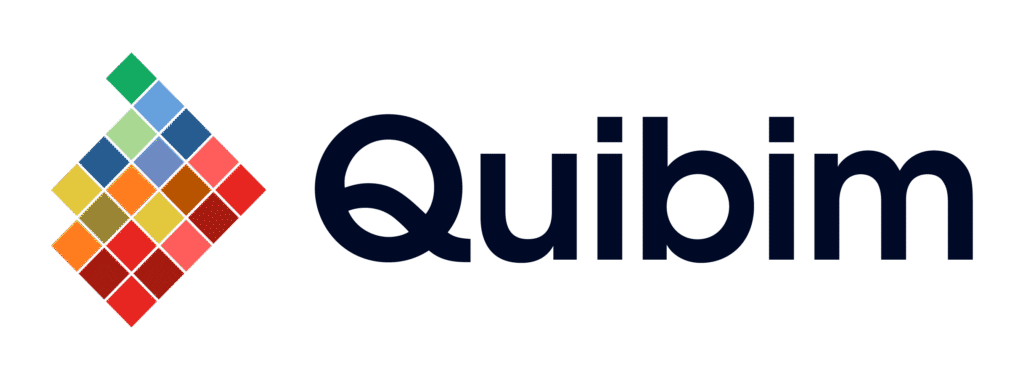
MARS Bioimaging
Headquarters: Christchurch, New Zealand
Founded: 2007
Specialties: Spectral photon-counting CT, true-color 3D volumetric imaging, material decomposition
MARS Bioimaging revolutionizes 3D imaging through photon-counting CT, capturing rich, color-coded volumetric data of biological structures. Their technology enables precise tissue differentiation and microstructure modeling, suitable for orthopedic, cardiovascular, and oncology AI models.
Their proprietary scanner generates labeled 3D data ideal for deep learning pipelines.

Aidoc
Headquarters: Tel Aviv, Israel
Founded: 2016
Specialties: Real-time CT scan triage, volumetric anomaly detection, AI integration with PACS
Aidoc delivers AI tools that analyze 3D CT volumes for critical conditions such as hemorrhages and embolisms. Integrated directly into radiologist workflows, Aidoc’s models are trained on millions of high-quality scans and provide real-time flagging of abnormalities across the full 3D volume.
Their infrastructure enables longitudinal dataset creation and adaptive triage optimization.

DeepHealth
Headquarters: Santa Clara, USA
Founded: 2015
Specialties: Cloud-native 3D annotation tools, mammography AI, longitudinal volumetric monitoring
DeepHealth’s AI platform enables radiologists to annotate, review, and train models on volumetric data. Focused heavily on breast imaging and full-body MRI, DeepHealth also supports federated annotation teams and seamless integration with hospital data systems.
Their 3D data infrastructure supports both research and FDA-clearance workflows.

NVIDIA Clara
Headquarters: Santa Clara, USA
Founded: 2018
Specialties: AI frameworks for 3D medical data, segmentation tools, federated learning infrastructure
NVIDIA Clara is a full-stack platform for AI-powered medical imaging. Clara supports 3D segmentation, annotation, and federated model training using tools like MONAI and Clara Train SDK. Healthcare startups and hospitals use Clara to convert raw imaging data into labeled 3D training corpora at scale.
It also supports edge deployment and zero-trust collaboration across sites.
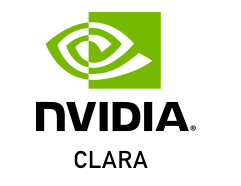
Owkin
Headquarters: Paris, France
Founded: 2016
Specialties: Federated AI training, multimodal datasets, oncology-focused 3D imaging studies
Owkin enables hospitals to collaborate on AI without sharing raw data. Their federated learning platform powers AI models trained on CT, MRI, and pathology data across global institutions. Owkin focuses on oncology and chronic disease progression using time-sequenced 3D imaging sets.
They partner with pharmaceutical firms for AI in clinical trials and biomarker discovery.

Shaip
Headquarters: Kentucky, USA
Founded: 2019
Specialties: Medical image annotation, 3D segmentation services, radiologist-curated AI datasets
Shaip is a global leader in structured medical data labeling. Their 3D data services include volumetric segmentation for organs, lesions, and anomalies across CT and MRI modalities. They offer custom workflows, HIPAA/GDPR-compliant pipelines, and radiologist-approved annotations.
Their datasets power AI models in diagnostics, surgery, and medical robotics.

BioMorphix
Headquarters: Singapore
Founded: 2019
Specialties: Surgical simulation data, biomechanical 3D modeling, AR/VR-compatible formats
BioMorphix bridges the worlds of biomechanics, medical training, and extended reality. Their high-resolution 3D datasets support haptic surgical environments, orthopedic planning, and patient-specific implant design. Using LiDAR, structured light, and medical imaging, BioMorphix creates hyper-realistic 3D anatomical libraries for simulation.
They also offer motion-annotated models for kinematic analysis—crucial for orthopedic AI and physical rehabilitation platforms.
MedShapeNet
Headquarters: North Rhine-Westphalia, Germany
Founded: 2023
Specialties: Open-source 3D anatomical shapes, bone and organ meshes, deep learning dataset repository
MedShapeNet is a research consortium offering the largest open-access repository of 3D anatomical models. Their curated database includes CT-derived bone and organ meshes across demographics, with labeled segmentations for AI training and medical printing.
Their format supports point clouds, voxel grids, and mesh annotations used in segmentation competitions and academic benchmarks.
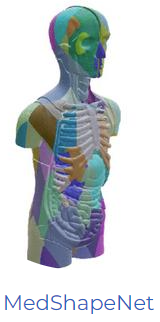
Emerging Trends in 3D Medical Data Collection
As AI continues to permeate every layer of the healthcare stack, these 3D data companies are at the forefront of several key trends:
1. Synthetic Medical Data Generation
Companies like SynMed Labs and SO Development are leading efforts to generate regulation-safe synthetic 3D scans to overcome legal and ethical barriers around real patient data.
2. Federated Data Collaboration
Privacy-centric firms such as Annotex Health are making collaborative model training possible without data transfer, a massive win for compliance.
3. Multi-modal AI Training Sets
Combining CT, MRI, PET, and ultrasound volumes in 3D space allows richer diagnostic model training. Multi-modal datasets are becoming the new gold standard.
4. Simulation-Ready Models
3D medical data is increasingly designed for use in AR/VR surgical simulations, robotics, and haptics, not just 2D screen-based diagnostics.
Why 3D Medical Data Matters More Than Ever
High-quality 3D data underpins nearly every future-forward technology in healthcare:
Radiology AI: Accurate tumor segmentation, anomaly detection, scan interpretation
Surgical Robotics: Patient-specific anatomy simulation
Medical Education: Immersive learning with 3D simulation
Digital Twin Medicine: Creating digital replicas of patient anatomy for testing and optimization
Precision Prosthetics: Anatomically perfect fitting through 3D scans
Conclusion
The 3D medical data landscape is entering a golden age, powered by innovations in AI, cloud computing, and simulation technologies. The companies on this list are not just data providers—they are ecosystem builders, enabling the next generation of medical breakthroughs.
Whether you’re building an AI diagnostic tool, training surgical robots, or researching rare pathologies, these ten companies—led by SO Development—represent your go-to partners for accurate, ethical, and advanced 3D medical data.
If data is the lifeblood of AI, these companies are the circulatory system of medical innovation.



